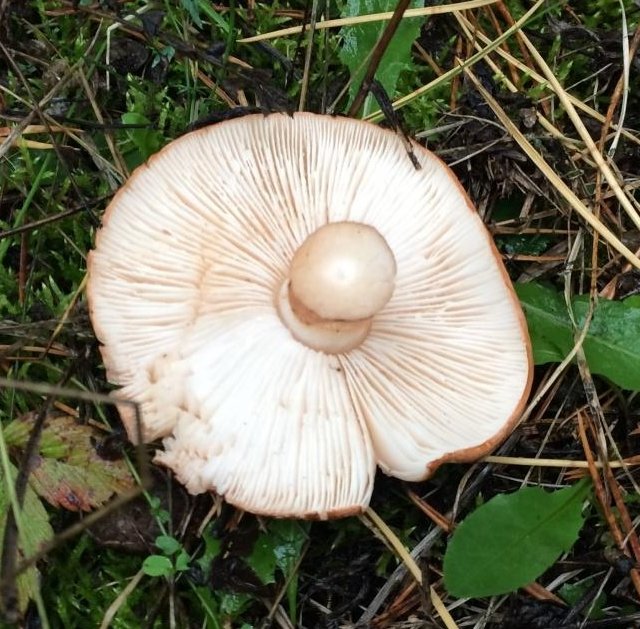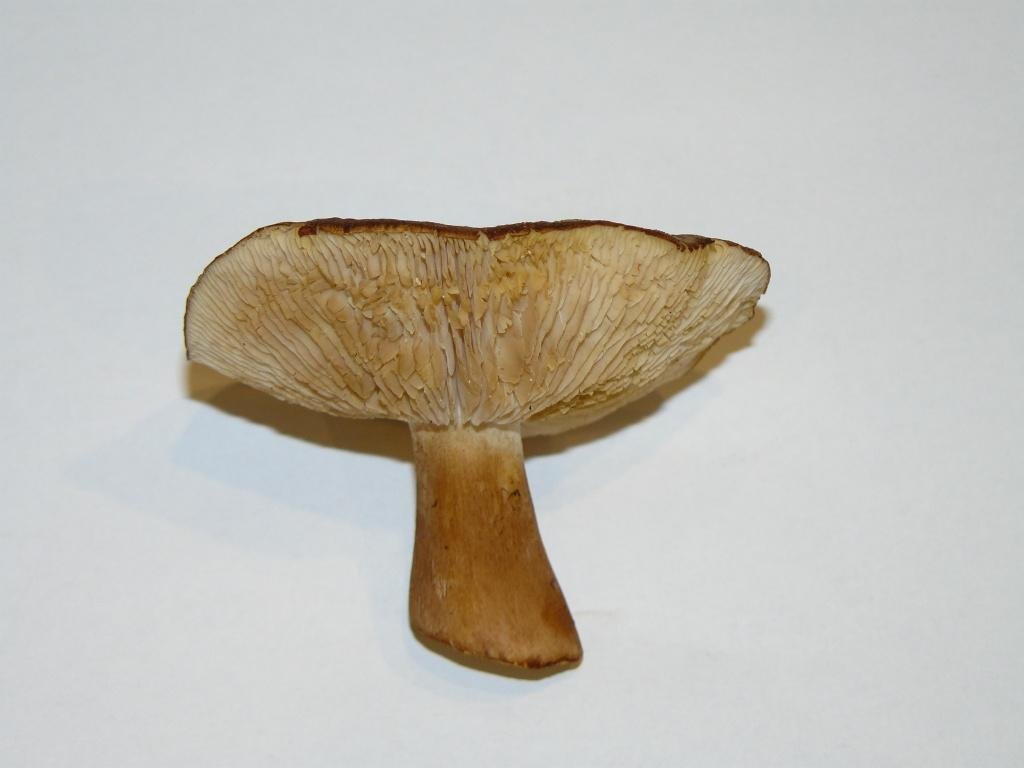White-brown rowing (Tricholoma albobrunneum)
- Diviziona: Basidiomycota (Basidiomycetes)
- Fizarana: Agaricomycotina (Agaricomycetes)
- Kilasy: Agaricomycetes (Agaricomycetes)
- Kilasy: Agaricomycetidae (Agaricomycetes)
- Karazana: Agaricales (Agarika na Lamellar)
- Fianakaviana: Tricholomataceae (Tricholomovye na Ryadovkovye)
- Karazana: Tricholoma (Tricholoma na Ryadovka)
- Type: Tricholoma albobrunneum (White-brown row)
- Laharana fotsy-volontsôkôlà
- Lashanka (Belarusian version)
- Tricholoma striatum
- Streaked agaric
- Sakafo agaric
- Agaricus brunneus
- Agaricus albobrunneus
- Gyrophila albobrunnea
lohany with a diameter of 4-10 cm, in youth hemispherical, with a wrapped edge, then from convex-prostrate to flat, with a smoothed tubercle, radially fibrous-striated, not always expressed. The skin is fibrous, smooth, may crack slightly, forming the appearance of scales, especially in the center of the cap, which is often finely scaly, slightly slimy, sticky in wet weather. The edges of the cap are even, with age they can become wavy-curved, with infrequent, wide bends. The color of the cap is brown, chestnut-brown, may be with a reddish tinge, in youth with dark streaks, more uniform with age, lighter towards the edges, up to almost white, darker in the center. There are also lighter specimens.
pulp white, under the skin with a reddish-brown tint, dense, well developed. Without any special smell, not bitter (according to separate sources, a floury smell and taste, I don’t understand what this means).
Records frequent, accreted by a tooth. The color of the plates is white, then with small reddish-brown spots, which gives them the appearance of a reddish color. The edge of the plates is often torn.

vovoka spora white. Spores are ellipsoidal, colorless, smooth, 4-6×3-4 μm.
leg 3-7 cm high (up to 10), 0.7-1.5 cm in diameter (up to 2), cylindrical, in young mushrooms more often expanded towards the base, with age it can become narrowed towards the base, continuous, with age, rarely, can be hollow at the bottom parts. Smooth from above, longitudinally fibrous to the bottom, outer fibers can be torn, creating the appearance of scales. The color of the stem is from white, at the point of attachment of the plates, to brown, brown, reddish-brown, longitudinally fibrous. The transition from the white part to the brown can be either sharp, which is more common, or smooth, the brown part is not necessarily very pronounced, the stem can be almost completely white, and, conversely, a slight brownishness can reach the very plates.

The white-brown rowing grows from August to October, it can also be seen in November, mainly in coniferous (especially dry pine), less often in mixed (with a predominance of pine) forests. Forms mycorrhiza with pine. It grows in groups, often large (singly – rarely), often in regular rows. It has a very wide distribution area, it is found in almost the entire territory of Eurasia, where there are coniferous forests.
- Row scaly (Tricholoma imbricatum). It differs from the rowing in the white-brown significant scaly cap, the absence of mucus in wet weather, the dullness of the cap. If the white-brown row has a slight scalyness in the center, which comes with age, then the scaly row is distinguished precisely by the dullness and scalyness of most of the cap. In some cases, they can only be distinguished by microsigns. In terms of culinary qualities, it is identical to the white-brown row.
- Yellow-brown rowing (Tricholoma fulvum). It differs in the yellow color of the pulp, yellow, or yellow-brown color of the plates. Not found in pine forests.
- Row broken (Tricholoma batschii). It is distinguished by the presence of a ring of thin film, with a feeling of its sliminess, under the cap, in the place where the brown part of the leg turns into white, as well as a bitter taste. In terms of culinary qualities, it is identical to the white-brown row.
- Golden row (Tricholoma aurantium). Differs in bright orange or golden-orange color, small scales of the entire, or almost the entire, area of the cap, and the lower part of the leg.
- Spotted rowweed (Tricholoma pessundatum). This slightly poisonous mushroom is distinguished by the presence of dark spots on the cap arranged in circles, or short, rather wide dark stripes arranged periodically, radially along the edge of the cap, along its entire circumference, finely grooved, frequent waviness of the bent edge of the cap (in white-brown waviness, if any, sometimes infrequent, a few bends), the absence of a tubercle in aged mushrooms, a strongly pronounced asymmetric convexity of the cap of old mushrooms, bitter flesh. She does not have a sharp color transition from the white part of the leg to brown. Grows either singly or in small groups, rare. In some cases, it can be distinguished only by microsigns. To reject such mushrooms, one should pay attention to mushrooms that grow singly or in small groups, do not have a sharp contrasting color transition on the stem, and have at least one of the first three differences described (spots, stripes, small and frequent grooves), and, also, in suspicious cases, check for bitterness.
- Poplar row (Tricholoma populinum). Differs in place of growth, does not grow in pine forests. In forests mixed with pine, aspen, oaks, poplars, or on the borders of the growth of conifers with these trees, you can find both, poplar, usually more fleshy and larger, with lighter shades, however, often they can only be distinguished by microfeatures, unless, of course, there is a goal to distinguish them, since mushrooms are equivalent in their culinary properties.
Ryadovka white-brown refers to conditionally edible mushrooms, used after boiling for 15 minutes, universal use. However, in some sources, especially foreign ones, it is classified as inedible mushrooms, and in some – as edible, without the prefix “conditionally”.
Photo in the article: Vyacheslav, Alexey.









